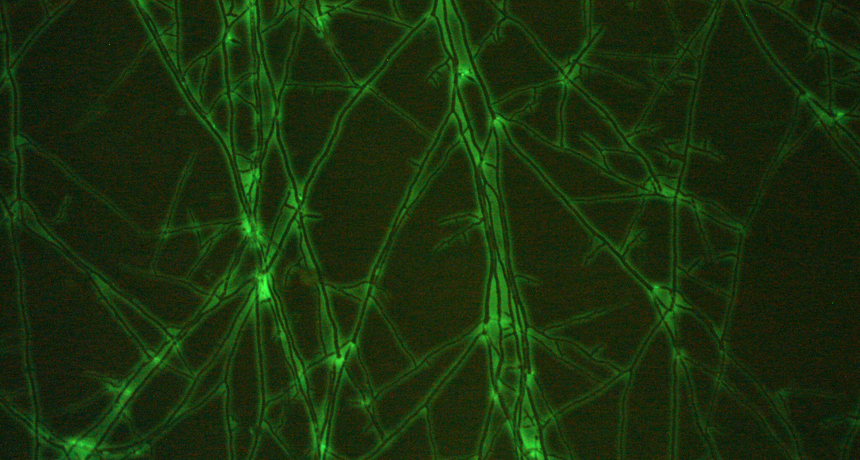
FUNGAL FARMERS Strands of the thick-footed morel fungus serve as a highway for common soil bacteria, marked with a glowing protein, traveling to new territory. The highways could be a fungal version of planting bacteria as a crop.
Martin Pion
A sought-after mushroom that people can’t farm might be the first fungus known to do some agriculture itself.
Human farmers have yet to reliably coax the thick-footed morel, one of several culinary morel species, into sprouting the mushrooms that chefs prize. People have gotten the Morchella crassipes fungus to form mats of fine strands but no stalked, wrinkly, spore-forming bodies to sauté.
Lab tests, however, suggest that these fungal strands themselves can do simple farming tasks. The morel can spread soil bacteria to new “fields” and cultivate them with fungal secretions that the bacteria consume, says microbial ecologist Pilar Junier of the University of Neuchâtel in Switzerland. The fungus can supplement its food suppy by taking up carbon from the bacteria, she and her colleagues report October 30 in Proceedings of the Royal Society B.
“My hope is that it will change the way people look at fungi,” Junier says.
Fungi have been the crop instead of the farmers in the story of the rise of sophisticated agriculture. Certain animals evolved elaborate food farms millions of years before people did. Ants in the tropics raise fungus on leaf snippets to nourish colonies of millions of individuals.
To see whether a fungus might have some farming skills, Junier and her colleagues paired the thick-footed morel with the common soil bacterium Pseudomonas putida. Farming wouldn’t be the fungus’ sole feeding option, Junier knew, because researchers had already found that it takes in nutrients from living plants or dead material.
Instead, Junier suspected that morels might be enhancing an extra food source by offering soil bacteria “fungal highways” for travel to new territory. Soil has a lot of air in it, she says, “and bacteria do not fly.” Long, wet strands of fungi provide easy-swim expressways. In lab dishes with the bacterium and the fungus, P. putida grew six times as dense as did a mutant strain of the bacterium that couldn’t swim.
Morels also might be cultivating the bacteria, in the sense of providing them with fungal secretions, the researchers hypothesized. To test the idea, the team let fungi incorporate distinctive forms of carbon into their bodies and then tracked nutrient flow. Fungal carbon traveled from the fungus into the bacteria.
In the end, the morels may be harvesting bacteria, Junier proposes. After about seven days of morel-bacterial cohabitation, bacterial populations faded while the fungi formed hard-walled resting structures called sclerotia. The fungus thus could be taking nutrients from the bacteria and storing what it extracts in the sclerotia. Tracking showed bacterial carbon ended up in the fungus, she and colleagues found.
The hard-walled sclerotia formed as far away as possible from the zones in the lab dishes where bacterial colonies had been introduced. The fungus could be moving some bacterial nutrients from the rich bacterial fields for storage in relatively nutrient-poor areas, Junier suggests.
This quirk suggests another test to determine whether the fungi are harvesting bacteria, says Ulrich Mueller of the University of Texas at Austin. He’d like to know if the sclerotia would still form in the same pattern if the bacterial colonies were cut away before the supposed harvesting.
Harvesting carbon didn’t actually improve the fungal growth rate, at least with the plentiful nutrients in the lab. Junier would like to follow up with fungi growing with skimpy nutrients and wild-collected bacterial strains. Regardless, she still considers the morel’s behavior agricultural. “We don’t need coffee to survive,” she says, “but we grow it.”






